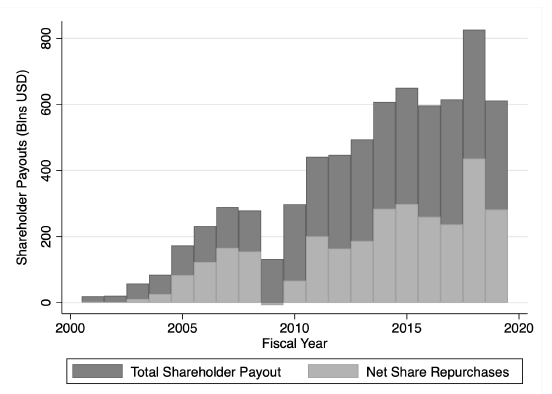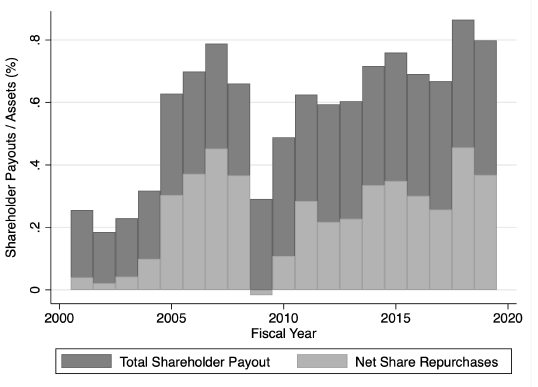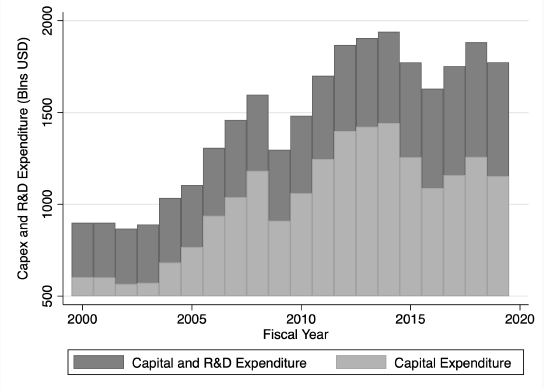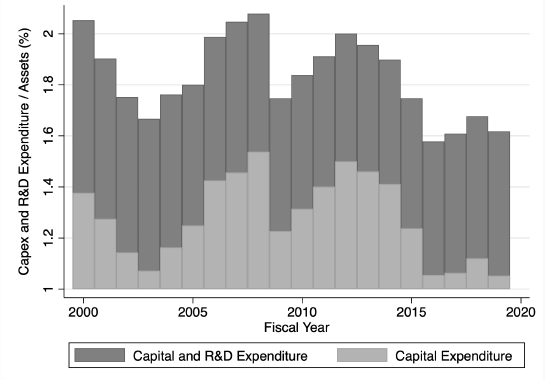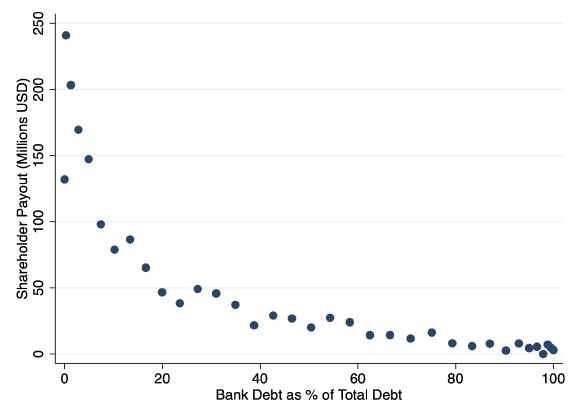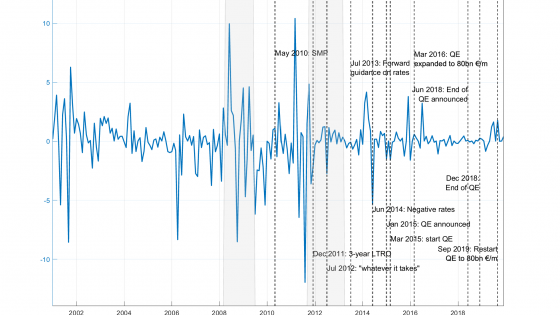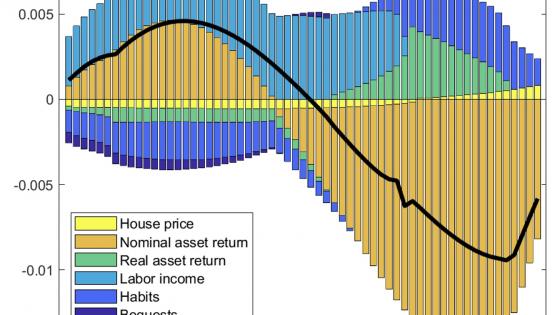The ultra-low US policy rates that followed the 2008 Global Crisis have been coincident with significantly large positive shareholder payouts by US firms, or in other words, negative net equity issuances, largely due to higher share buybacks (repurchases) than ever in the past. Net share repurchases and total shareholder payouts (the sum of net share repurchases and dividend payouts) have increased steadily since 2001 (in absolute terms as well as relative to assets), especially so in the past decade, reaching a peak of more than $800 billion in 2018 (Figure 1). Over this period, fixed business investment growth has failed to keep pace with firm assets, leading to lower normalised investment despite cheap funding due to aggressive monetary easing and favorable tax reforms (Figure 2b).
Several observers, policymakers, and politicians see a causal link between these two trends, whereby the increase in share buybacks inefficiently diverts internal corporate funds from profitable investment opportunities, thus leading to disappointing capital expenditures. This view has led to calls for a tight regulation of share buybacks. Taken at face value, the claim that payouts to shareholders have inefficiently crowded out aggregate corporate investment seems of little merit. Only an extremely poor governance across the board could lead US firms to forego value-creating investment opportunities and return cash to shareholders on aggregate instead.
Most recently, in the wake of the COVID-19 outbreak, former Federal Reserve Chair- man Janet Yellen has acknowledged that large debt burdens of non-financial corporations reflected excessive borrowing, much of which was not spent on productive investments, but rather used to distribute cash to shareholders, and that the Federal Reserve did not possess the adequate tools to regulate such use of leverage in response to low interest rates.1
Figure 1 Total net share repurchases and shareholder payouts (defined as the sum of net share repurchases and dividend payouts)
a) Levels of repurchases and payouts
b) Repurchases and payouts normalised by firm assets in the prior quarter
Source: Data from Compustat, 2001-2019 (inclusive).
Figure 2 Total capital and R&D expenditures
a) Levels of expenditure
b) Expenditures normalised by firm assets in the prior quarter
Source: Data from Compustat, 2001-2019 (inclusive).
In our recent work (Acharya and Plantin 2020), we show how a socially undesirable yet shareholder value-maximising crowding out of business investment by payouts can arise as an unintended consequence of aggressive monetary easing. The first step in our reasoning is to acknowledge that the recent wave of share buybacks has been largely debt-financed. Payouts in the last decade really have been leveraged payouts whereby firms have sold debt to repurchase equity, and thus significantly increased their leverage, which was at a historically high level at the outbreak of the COVID-19 crisis.
Our paper offers a parsimonious model in which a low monetary policy rate leads to large leveraged payouts by firms that have a detrimental impact on capital expenditures, leading to business investments that are too low from a social perspective. This adverse effect of low rates occurs only when the public sector is unable to regulate private leverage; conversely, an appropriate prudential regulation on leverage in combination with a low monetary policy rate can restore the first-best investment level. Thus, we offer an equilibrium relationship between several salient features of the current corporate credit cycle: the significant involvement of a large unregulated shadow-banking sector, historically unprecedented levels of leveraged payouts, and disappointing capital expenditures. The gist of our argument is as follows: consider a firm endowed with a technology that converts date- 0 investments into date-1 profits with decreasing marginal returns to scale. The firm is price-taker in a bond market. As the required return on bonds decreases, the firm (i) invests more until the marginal return equates the return on bonds, and (ii) borrows more against future profits to fund share buybacks (or a special dividend depending on the best regulatory and tax treatment) until shareholders’ marginal rate of inter-temporal substitution also equates bond returns. Shareholders, like all economic agents, value such a frontloading of consumption in the face of lower interest rates.
Suppose now that the relationship between the firm and its creditors is plagued by a standard agency problem such as moral hazard—we also consider adverse selection or liquidity risk as alternative frictions in the paper. The output from investment increases in costly private effort exerted by the firm. Such moral hazard introduces a tension between investment and leveraged payouts as the interest rate decreases. On the one hand, the shareholders would like to enter into more leveraged payouts to front-load consumption. On the other hand, borrowing more against date-1 output reduces the firm’s skin in the game and incentives to increase this output, thereby making investment less profitable and thus smaller. The firm sets its leverage at the level that optimally trades off consumption- smoothing and incentives.
This privately optimal leverage is not the socially optimal one, however, when the low rate stems from aggressive monetary easing by a monetary authority seeking to spur investment. In this case, whereas reduced effort and investment are deadweight social losses, shareholders’ benefits from leveraged payouts at a distorted rate are a social wash because they must be paid for by other agents—in the form of taxes on savers in our setup. In sum, our parsimonious model offers a clear connection between monetary easing and the rise of leveraged payouts at the expense of capital expenditures and productivity. It has noteworthy implications for financial regulation and optimal monetary policy.
Implications for financial regulation
We show that the central bank can implement the first best despite moral hazard if it has a free hand at regulating corporate leverage. We view the difference between a setting in which it can do so and one in which entrepreneurs lever up as they see fit as a stylized parallel between an economy in which corporate credit originates from regulated banks and one in which it also stems from non-banks—the ‘shadow banking’ sector. We show that monetary easing entails more leveraged payouts at the expense of productive investment in the latter situation than in the former. Accordingly, our theory suggests that the existence of a large shadow banking system (as has been the case in the US over the last decade) may dramatically affect the transmission of monetary policy.
Implications for optimal monetary policy
We show that when it cannot regulate leverage, the central bank optimally targets a strictly smaller investment level than when it can regulate leverage. Stimulating investment with low rates comes at the cost of inducing leveraged payouts, which reduce entrepreneurs’ incentives and thus productive efficiency. A smaller investment target compared to the first-best optimally trades off scale and productive efficiency. If the pass-through from monetary policy to investment level is rather muted, as observed recently,2 then the optimal monetary policy may even consist of ‘leaning against the wind,’ i.e. not stimulating the economy at all, in order to fully contain leveraged payouts and maintain productive efficiency.3
We also see some empirical support for our model in the data. Unregulated leverage is an important source of financing for payouts—the firms which account for the vast majority of payout volume are financed largely by non-bank debt (Figure 3). Given the reliance on unregulated leverage (e.g. bond financing), we also find that accommodative monetary policy is supportive of increased payout activity. Figure 4 shows that payout activity is higher during periods of looser monetary policy, and furthermore that this difference is the most pronounced for those firms which rely more heavily upon unregulated (non-bank) leverage.
Figure 3a Total shareholder payout (billions USD), defined as the sum of net share repurchases and dividend payouts, split by above and below median proportion of bank debt to total debt
Figure 3b Binscatter of shareholder payouts (defined as the sum of net share repurchases and dividend payouts) against bank debt as a proportion of total debt
Overall, our paper revisits the notion of ‘malinvestment’ that has been prominent in Austrian economics (e.g. Hayek 1931). Malinvestment refers to the possibility that distortion of the real interest rate due to monetary easing subsidizes activities that are not socially desirable (but become privately profitable) at the expense of preferable investments. We are the first, to our knowledge, to connect the current fierce debate on the social optimality of leveraged share buybacks to this old idea of malinvestment.
Figure 4 Difference in total shareholder payout (sum of net repurchases and dividends) during low (bottom quartile) and high (top quartile) monetary policy shocks.
References
Acharya, V and G Plantin (2020), “Monetary Easing, Leveraged Payouts and Lack of Investment”, Working Paper, NYU Stern School of Business.
Furman, J (2015), “Business Investment in the United States: Facts, Explanations, Puzzles, and Policies”, Council of Economic Advisers, Remarks at the Progressive Policy Institute.
Hayek, F A (1931), Prices and Production, New York: Augustus M. Kelley Publishers.
Romer, C D and D H Romer (2004), “A New Measure of Monetary Shocks: Derivation and Implications”, American Economic Review 94 (4).
Stein, J C (2012), “Monetary Policy as Financial-Stability Regulation”, Quarterly Journal of Economics 127 (1).
Wang, O (2019), “Banks, Low Interest Rates, and Monetary Policy Transmission”, Working Paper, NYU Stern School of Business.
Yellen, J (2020), “COVID-19 and the Economy: What Washington has done and the challenges to state and local governments”, Remarks at the Brookings Institution.
Endnotes
1 Yellen said the high level of corporate debt across Wall Street could make for a more difficult recovery from the coronavirus pandemic. Although the banking and financial sector entered the economic crisis brought on by the novel coronavirus outbreak in “generally good shape”, Yellen noted that “nonfinancial corporations entered this crisis with enormous debt loads, and that is a vulnerability”, citing the Fed’s inability to regulate excessive borrowing, which was supported by very low interest rates.
2 Besides Furman (2015), see also the evidence presented for the United States by Wang (2019), who documents a weak pass-through of monetary policy to bank lending rates for the past two decades, especially so at low interest rates. See also the discussion and references in Wang (2019) for similar evidence of a weak pass-through of negative interest rates to the real economy in case of Europe and Japan.
3 This idea is consistent with Stein (2012), which notes that “leaning against the wind” could beoptimal monetary policy in the presence of some unchecked credit growth in the shadow-banking system, as it raises the cost of borrowing in all “cracks” of the financial sector.

